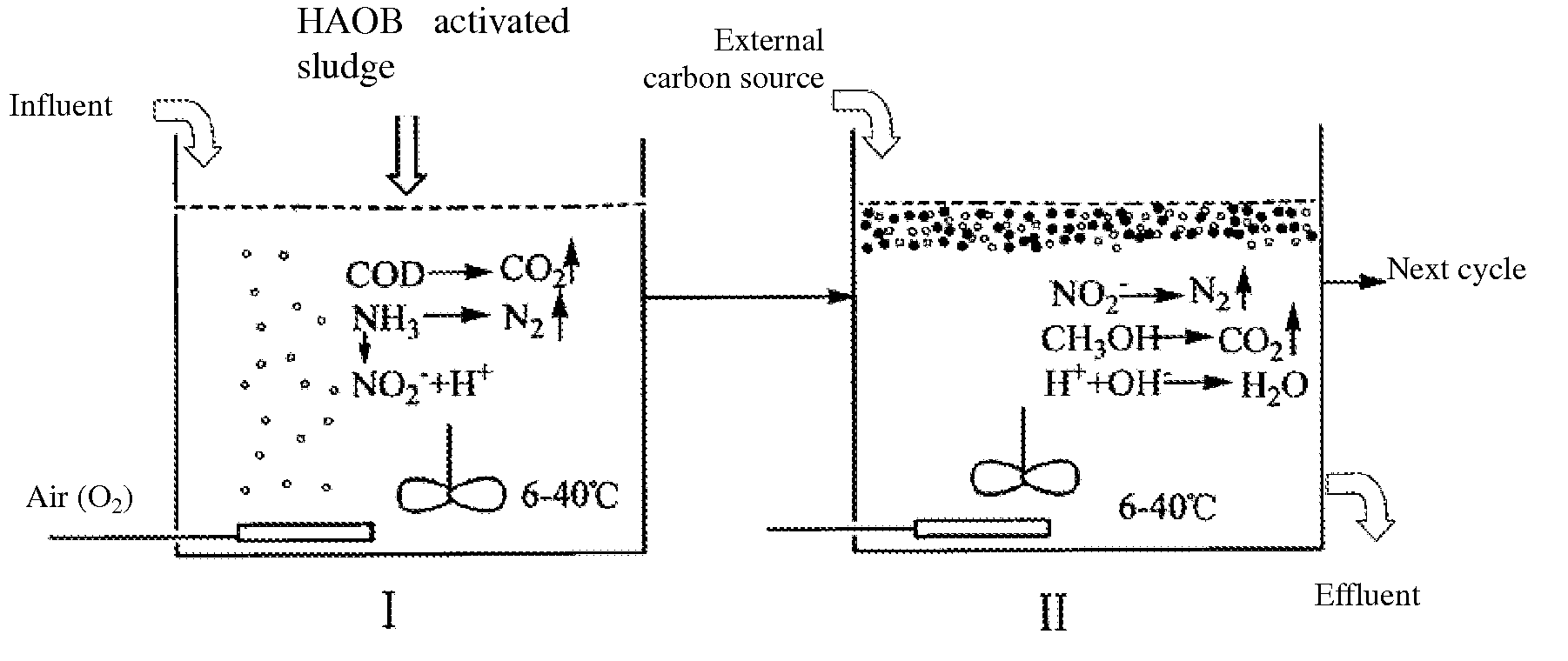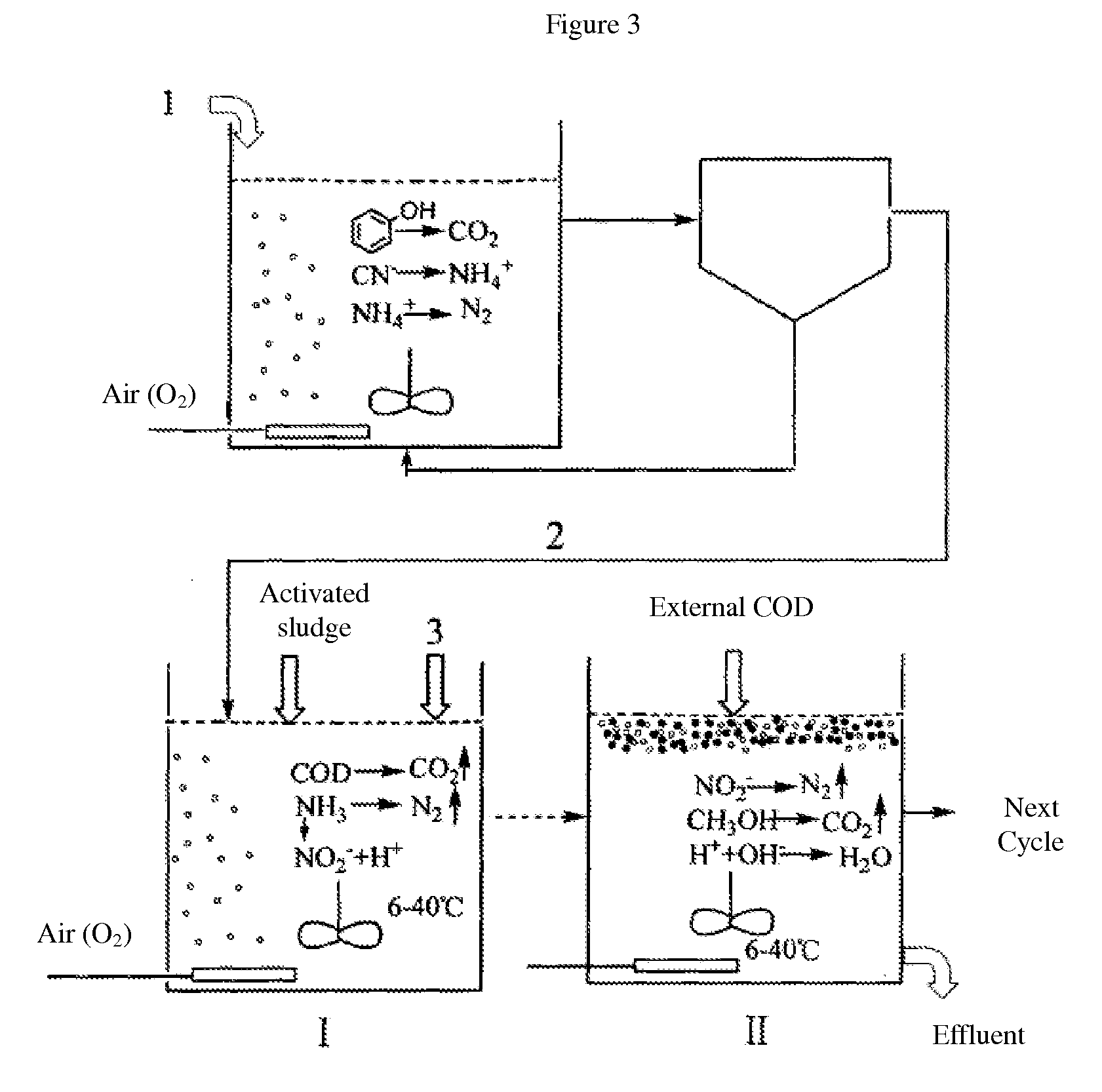Method for removing the contamination of c,n utilizing heterotrophic ammonia-oxidizing bacteria
a technology of ammonia-oxidizing bacteria and c,n, applied in the direction of biological water/sewage treatment, sustainable biological treatment, natural treatment water, etc., can solve the problems of deterioration of natural water quality, insufficient ammonia removal of conventional biological methods aiming at removing organic carbon (cod), low efficiency nitrification, etc., to reduce unnecessary power consumption and optimize the process
- Summary
- Abstract
- Description
- Claims
- Application Information
AI Technical Summary
Benefits of technology
Problems solved by technology
Method used
Image
Examples
example 1
[0153]This example used Wushantu as seed in the sludge cultivation process.
[0154]The composition of the organic pre-culture medium used for HAOB cultivation was listed below:
Yeast ExtractTrypon(NH4)2SO4NaH2PO4K2HPO4FeSO4•7H2OMnSO4•H2OMgSO4•7H2O2.36 g2.36 g2.50 g0.63 g1.80 g0.03 g0.03 g0.09 g
[0155]The culture substrate was prepared by dissolving the organic pre-culture medium with tap water and heating, and then diluted to 2500 ml; pH was adjusted to the range of 7.0˜7.2; CODcr=1.99×103 mg / L, TKN=TN=424 mg / L; organic N: inorganic N=1:1.
[0156]5 g dry Wushantu was seeded into the above 2500 ml culture substrate (TICN=424 mg / L). Continues aeration was carried out at 28° C. for 2 days until NO2−—N reached 0.5-1.0 mg / L. Acetic acid (HAc) or sodium acetate (NaAc) as carbon source was added into the solution twice every day (every 12 hours). The carbon source amount each time was 0.28 ml anhydrous HAc per liter solution or 0.40 g anhydrous NaAc per liter solution, corresponding to an equiva...
example 2
[0169]Example 2 describes the application of the activated sludge seeded from Wushantu in example 1 to treat modeled wastewater of high organic carbon and nitrogen concentration.
[0170]The activated sludge seeded from Wushantu in example 1 was taken as inoculums. The process was performed according to the flow chart shown in FIG. 1: Reaction was stopped when ammonia fell below 3 mg / L (no NO2−—N or NO3−—N accumulation); water was discharged and the sludge was left. The process was repeated continuously for 12 months, during which no sludge was discharged. Related technical parameters and treatment results were shown in Table 11.
TABLE 11Technical parameters for consecutive treatment of modeledwastewater with high organic carbon and nitrogen wastewater(TKN = 424) using activated sludge seeded from WushantuTimes of continuous treatment1st time2nd time3rd time4th time5th timeInitial sludge concentration (mg / L)2000Raw wastewaterModeled wastewater of high organic carbon and nitrogenconcentr...
example 13
1. Activated Sludge Cultivation Using Yutu Soil as Inoculum
[0190]The activated sludge cultivation using Yutu soil as inoculum was carried out by the same procedures as that described in Example 1. The cultivation time and amount of carbon source might differ slightly because of the difference in physicochemical properties of the soils, the composition of microorganisms, especially the HAOB species exhibiting high ammonia-to-nitrite oxidation activity. Bacillus pseudofirmus NH-2 dominated in Yutu soil while Arthrobacter globiformis WR-2 dominated in Wushantu soil.
2. The Consecutive Treatment of Modeled Wastewater of High Organic Carbon and Nitrogen Wastewater Concentration Using Activated Sludge
[0191]Following the above cultivation approach but at 15° C. in the 150 Litre bucket reactor, Yutu soil was cultivated for 23 days, and then the sludge was filtered and served as inoculum. Table 23 showed the treatment results of modeled wastewater of organic carbon and nitrogen concentration....
PUM
 Login to View More
Login to View More Abstract
Description
Claims
Application Information
 Login to View More
Login to View More - R&D
- Intellectual Property
- Life Sciences
- Materials
- Tech Scout
- Unparalleled Data Quality
- Higher Quality Content
- 60% Fewer Hallucinations
Browse by: Latest US Patents, China's latest patents, Technical Efficacy Thesaurus, Application Domain, Technology Topic, Popular Technical Reports.
© 2025 PatSnap. All rights reserved.Legal|Privacy policy|Modern Slavery Act Transparency Statement|Sitemap|About US| Contact US: help@patsnap.com



